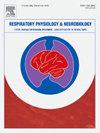选择性NaV1.7阻滞剂PF-05089771减轻豚鼠变应性鼻炎相关咳嗽的有效性
IF 1.6
4区 医学
Q3 PHYSIOLOGY
引用次数: 0
摘要
背景:变应性鼻炎(AR)是慢性咳嗽的常见原因,通过炎症介质与气道C-和a -纤维失调有关。尽管目前的止咳疗法疗效有限,但最近的研究表明,NaV1.7抑制剂可以阻断naïve豚鼠的咳嗽。本研究旨在分析NaV1.7阻滞剂PF-05089771对ar豚鼠咳嗽的影响。方法:Dunkin Hartley豚鼠致敏,卵清蛋白(OVA)攻毒。用柠檬酸气雾剂(0.4M)在灌鼻前及灌鼻后1、3、6 h诱导咳嗽。OVA-inhibitor组在吸入性牙周菌前吸入NaV1.7阻断剂(PF-05089771, 100μM)进行预处理。结果:慢性AR增加了男性和女性对柠檬酸的咳嗽反应。在不影响呼吸频率的情况下,NaV1.7阻滞剂对男性咳嗽反射的抑制率约为75%,对女性咳嗽反射的抑制率约为80%。结论:吸入NaV1.7阻滞剂可有效抑制豚鼠急性呼吸道变应性咳嗽。本文章由计算机程序翻译,如有差异,请以英文原文为准。
Effectiveness of selective NaV1.7 blocker PF-05089771 in reducing cough associated with allergic rhinitis in guinea pigs
Background
Allergic rhinitis (AR) is a common cause of chronic cough, linked to dysregulated airway C- and Aδ-fibres through inflammatory mediators. Despite the limited efficacy of current antitussive therapies, recent studies show that the NaV1.7 inhibitor can block cough in naïve guinea pigs. This study aimed to analyse the effect of the NaV1.7 blocker PF-05089771 on cough in guinea pigs with AR.
Methods
Dunkin Hartley guinea pigs were sensitised and challenged with ovalbumin (OVA). Cough was induced using citric acid aerosol (0.4 M) before nasal challenge (NCH), and then one hour after the 1st, 3rd, and 6th NCH. The OVA-inhibitor group was pre-treated with inhaled NaV1.7 blocker (PF-05089771, 100 μM) before tussigen inhalation.
Results
Chronic AR increased cough response to citric acid in both males and females. Pre-treatment with NaV1.7 blocker significantly inhibited cough reflex by ≈ 75 % in males and ≈ 80 % in females without affecting respiratory rate.
Conclusion
NaV1.7 blocker inhalation effectively inhibits cough in guinea pigs with AR.
求助全文
通过发布文献求助,成功后即可免费获取论文全文。
去求助
来源期刊
CiteScore
4.80
自引率
8.70%
发文量
104
审稿时长
54 days
期刊介绍:
Respiratory Physiology & Neurobiology (RESPNB) publishes original articles and invited reviews concerning physiology and pathophysiology of respiration in its broadest sense.
Although a special focus is on topics in neurobiology, high quality papers in respiratory molecular and cellular biology are also welcome, as are high-quality papers in traditional areas, such as:
-Mechanics of breathing-
Gas exchange and acid-base balance-
Respiration at rest and exercise-
Respiration in unusual conditions, like high or low pressure or changes of temperature, low ambient oxygen-
Embryonic and adult respiration-
Comparative respiratory physiology.
Papers on clinical aspects, original methods, as well as theoretical papers are also considered as long as they foster the understanding of respiratory physiology and pathophysiology.

 求助内容:
求助内容: 应助结果提醒方式:
应助结果提醒方式:


